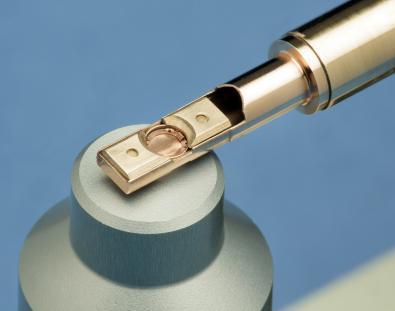- Motorized rotational control for high-throughput applications
- Interfaces with the Thermo Fisher Scientific transmission electron microscope (TEM) control system
- Maximizes tomographic data obtained from the specimen
- Allows for remote control of rotation and dual-axis functionality
- Extended field of view even at high-tilt angles
- FlexiClamp提供一个容易,秒ure means of specimen retention
- Non-motorized version available
Precise,in situplanar rotation
The Model 2045 Motorized Dual-Axis Tomography Holder is based on the revolutionary Model 2040 Dual-Axis Tomography Holder. The Model 2045 is designed for room-temperature applications when TEM tomographic imaging or analysis requires software-controlled, automated, in-plane rotation of the specimen. The specimen drive is motorized and interfaces with the microscope’s control system, which allows full software integration of both specimen tilt and rotation.
The Dual-Axis Tomography Holder features an optimal tilt-angle range in narrow gap (~5 mm) pole piece geometries. A fully jeweled mechanism provides ultra-precise, in-plane, specimen rotation while maintaining eucentric height.
The specimen can be automatically rotated from +180° to -180° to initially orient either the grid bars or a specimen feature to the alpha-tilt axis. After the acquisition of the first tilt series, the specimen can then be rotated 90° with respect to the first orientation for the subsequent acquisition of the second tilt series.
Acquiring a dual-axis tilt series enhances the quality of information contained in the tomogram. Motorization is essential when conducting conical tilt tomography, as well as any other high-throughput application.
Automation through the microscope facilitates dual-axis tomography via remote operation, which is especially useful for TEMs that are located in an enclosed environment.
The holder features a FlexiClamp, a spring-type, annular ring that securely clamps the specimen into the specimen cup. It maximizes specimen visibility, even at high-tilt angles.



